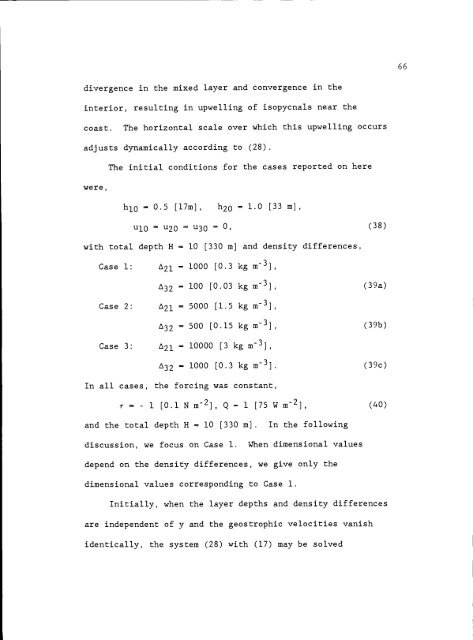Observations and Modelling of Fronts and Frontogenesis
Observations and Modelling of Fronts and Frontogenesis
Observations and Modelling of Fronts and Frontogenesis
You also want an ePaper? Increase the reach of your titles
YUMPU automatically turns print PDFs into web optimized ePapers that Google loves.
divergence in the mixed layer <strong>and</strong> convergence in the<br />
interior, resulting in upwelling <strong>of</strong> isopycnals near the<br />
coast. The horizontal scale over which this upwelling occurs<br />
adjusts dynamically according to (28).<br />
were,<br />
The initial conditions for the cases reported on here<br />
h10 - 0.5 [17m] , h20 = 1.0 [33 ml,<br />
ulO=u20=u30=O,<br />
with total depth H = 10 [330 m] <strong>and</strong> density differences,<br />
Case 1: 2l - 1000 [0.3 kg m3],<br />
(38)<br />
32 - 100 [0.03 kg m3] , (39a)<br />
Case 2: 2l = 5000 [1.5 kg m3],<br />
'32 = 500 [0.15 kg m3] , (39b)<br />
Case 3: 2l 10000 [3 kg m3],<br />
32 = 1000 [0.3 kg m3]. (39c)<br />
In all cases, the forcing was constant,<br />
r = - 1 [0.1 N m2], Q 1 [75 W m2], (40)<br />
<strong>and</strong> the total depth H 10 [330 ml. In the following<br />
discussion, we focus on Case 1. When dimensional values<br />
depend on the density differences, we give only the<br />
dimensional values corresponding to Case 1.<br />
Initially, when the layer depths <strong>and</strong> density differences<br />
are independent <strong>of</strong> y <strong>and</strong> the geostrophic velocities vanish<br />
identically, the system (28) with (17) may be solved















